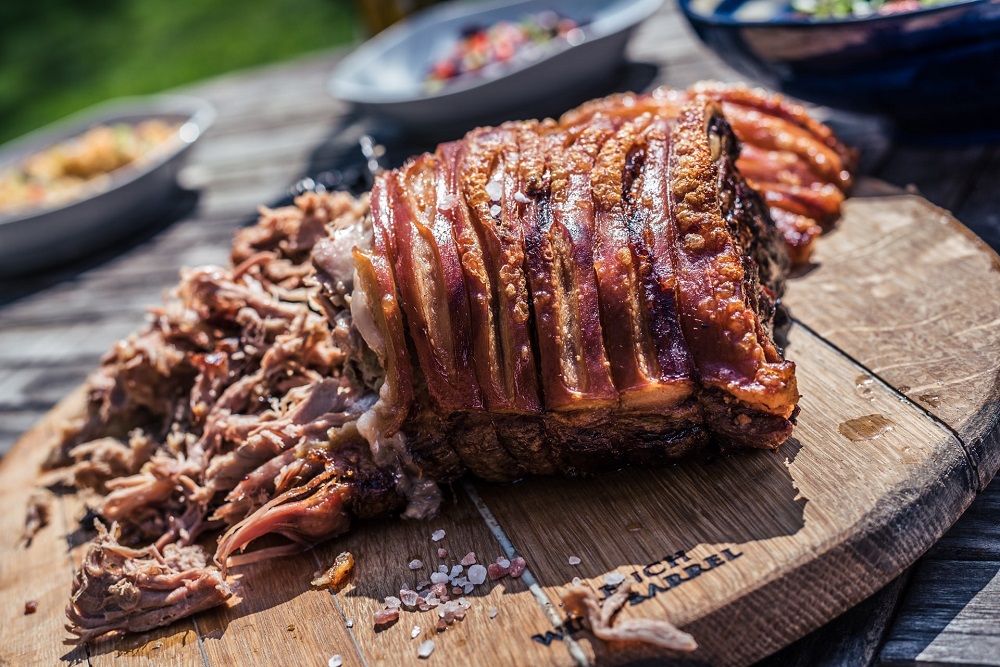When smoking a pork shoulder, temperature is critical. You want to cook it low and slow, to keep it moist, but you also need to make sure that the meat reaches a safe and desired internal temperature. This guide will show you how long to smoke a pork shoulder at 250 degrees Fahrenheit, the pork shoulder recipe and what other tricks are involved with smoking meat.
How Long To Smoke a Pork Shoulder at 250
If you plan on grilling or smoking your pork shoulder at 250 degrees Fahrenheit, it will take about 90 minutes per pound for the meat to cook through. This type of cooking allows the fat and connective tissues to break down nicely while the exterior gets nice and crispy. Smoking low and slow breaks down the fat to create a smoky, melt-in-your-mouth flavor.
Smoke the pork shoulder at 250 degrees F. until the internal temperature reaches 195 to 205 degrees F. and rest for an hour before serving. The flavorful dry rub helps produce a succulent bark on the outside while the salt penetrates all the way through, bringing out all that amazing pork flavor and tenderness.
Have you recently smoked pork shoulder for the first time? If you’ve never prepared slow-cooked pork shoulder before, it will be a real treat. Pork shoulder is an intensely flavorful cut of pork with a high fat-to-meat ratio. When cooked over a low fire for hours, the meat gets tender and flavorful.
What is Pork Shoulder?
Pork shoulder is a fatty, connective tissue rich cut of meat that can be intimidating to look at. The long cooking process will allow the fat to cook down, resulting in a flavorful and juicy pulled pork.
Different types of pork shoulder are available, so be aware of what you’re buying. There are two types of pork shoulder: the Boston butt and the pork picnic.
The upper shoulder, called pork butt or Boston butt, is the most popular piece of meat for barbecue. The lower shoulder and leg region, called picnic shoulder, is less popular but can be just as delicious. If you see either of these items on sale, know that they are both just pork shoulder and can be substituted for each other when making pulled pork.
Pork Butt vs. Picnic Shoulder
A whole pork shoulder consists of two different cuts – the picnic shoulder and the pork butt. The picnic shoulder is a cut that has a similar flavor and texture to the pork butt, but it has a slightly different shape. The cuts are usually sold separately.
If you go to the butcher and ask for pork shoulder, he may assume that you are asking for pork butt. Pork butt is a cut of meat from the pig’s upper shoulder region. It is usually square-shaped and can be cooked in many ways, such as roasted, grilled, or braised.
The Pork Butt is a fatty, meaty cut of meat that is typically sold skinless and with the bone in. It has great marbling and isn’t as tough or sinewy as a picnic shoulder. The fatty marbling makes it perfect for slow cooking.
Picnic shoulder is the lower shoulder and leg of a pig. It’s tougher than pork butt since pigs use this muscle region a lot, so it may require a longer smoking time than pork butt. Unlike pork butt, it’s usually sold with the skin on, which renders (gets crispy), and helps keep the pork moist while smoking.
In general, cook pork to an internal temperature of 145 degrees F. in order to consume it safely. Nevertheless, pork shoulder will need more time in the smoker than lean cuts like tenderloin and chops to reach higher temperature internally to break down the connective tissues.
If you’re planning to slice the pork shoulder, 185 degrees F. is an acceptable internal temperature. For pork that’s tender enough to fall apart when shredded with a fork, you’ll need to wait a bit longer. When making smoked pulled pork, aim to maintain an internal temperature of around 195 to 205 degrees F.
Most pulled pork recipes recommend smoking at 225 to 250 degrees F. If you’re cooking boneless pork shoulder at 250 degrees F., it should cook for about 1.5 hours or 90 minutes per pound. If you’re a true fan of barbecue, the end result is well worth the wait.
If you’re looking to make smoked pulled pork, the recommended temperature of a smoker is actually 225 degrees F.. This will take two hours per pound to smoke to desired internal temperature though, so a 25-degree difference can be a real time-saver.
Fat Side Facing Up
Don’t remove too much of the fat before applying the seasoning rub. If you want to remove some of the fat from pork butt, it’s important to be mindful of how much you trim away. Removing too much could result in a less flavorful smoked pork butt.
When smoking a pork shoulder, always place it so that the fat side is facing up. If the fatty side is facing up, it will slowly baste the meat as it renders, which is exactly what you want.
Avoid Overcooking
If you don’t remove the smoked pork shoulder from the heat when the internal temperature reaches 205 degrees F., it will start to dry out.
While it is important to get a dark crust on the exterior of your food during cooking, there’s a delicate balance between achieving that desired effect and ending up with charred meat. Many first-timers make the mistake of overcooking pork shoulder by leaving it on the smoker for too long.

Should I Brine or Inject Pork Shoulder?
Brining prevents pork shoulder from becoming dehydrated while cooking. The meat will be much moister and have a more flavorful taste. As a general rule of thumb, brine an 8-pound pork shoulder between 12 to 24 hours. It does take a long time to brine, but the end result is well worth the wait.
On the other hand, an injection can help tenderize meat and add flavor to it. Injecting pork shoulder with a flavor enhancer will ensure that the meat remains juicy and tender while cooking. To get moisture and flavor into the interior of the meat, you can use equal parts apple cider vinegar and apple juice or water.
Some people like to do both processes, which can produce great results or be a salty disaster. To get the best results, you can use a trusted brine recipe and remove the salt from the injection recipe. Use complementary flavors of wine and unsalted butter instead of stock. Finish things off with your favorite smoking woods like maple or apple wood.
About Stall Phase in Smoking the Pork Shoulder
Experienced pitmasters know about the pork shoulder stall phase. Here’s what you need to know if you want to shorten the whole smoking process:
After cooking the 8 lb boston butt for four to five hours, check the internal temperature using an instant-read meat thermometer. If your pork shoulder stalls cooking, it is likely that the temperature has reached a plateau. There is a gradual rise until the stall, and then there is a long period of flatlining.
At this point, the internal temperature shall be between 150 to 170 degrees F. The moisture in the pork begins to evaporate, which keeps the temperature from rising any higher. The fat and collagen in the pork butt liquify at this time, which slows down the rise in temperature. You shall take the meat off the smoker when the stall happens.
After removing the pork from the heat, wrap it tightly in tin foil or butcher paper. This will help to absorb a nice hit of smoke flavor and prevent moisture from evaporating, resulting in faster cooking. Butcher paper or foil will help to speed up the breaking down of the connective tissue and shorten the time spent in stall.
The difference between foil and paper is foil doesn’t breath, so the bark is a little better with paper. Smoke the meat for another two to three hours, and it should reach the 195 to 205 degree F. range.
This trick is to shorten the stall phase, but it is not absolutely necessary; Eventually, the temperature of the pork shoulder will continue to rise and reach 195 to 205 degrees F. at an estimated cooking time of about 90 minutes per pound of meat.
How Long To Smoke a Pork Shoulder at 250 – Easy Guide
You can use the following prep and smoking processes whether you’re using an electric smoker or pellet smoker, or pellet grill.
Prep the Pork Shoulder
Prepping a pork shoulder for smoking can be time-consuming, so it is important to do it as early in the process as possible.
You can season the pork shoulder by soaking it in your homemade marinade, dry rubbing it with spices, or injecting it with your favorite sauce or spices. Place the pork roast in a large pan and refrigerate overnight.
For this pork shoulder recipe, cut away the excess fat. To score the fat cap of a piece of meat before cooking it, use a sharp knife to make crosshatch patterns on the surface. This will create more surface area that is exposed to heat, which will result in even cooking. Pat it dry using a paper towel. Next is to season the pork with kosher salt and a dry rub.
Place the pork shoulder in a roasting pan before seasoning. To prepare the pork shoulder for smoking, apply a thin layer of yellow mustard or olive oil to it to create a paste that the rub will stick to. Add some brown sugar to your rub to add flavor and create a nice bark on the pork shoulder.
Apply the dry rub to the shoulder. Pat the rub into the shoulder so it can stick better. Wrap the shoulder in plastic wrap and refrigerate for 12 hours or over night.
Remove the pork shoulder from the fridge 1 hour before you are going to smoke it. This will help bring the internal temperature closer to room temperature and reduce the time it takes to smoke. Letting the shoulder rest on a counter before smoking will also develop a nice smoke ring on it as well.
Smoking Process
Preheat your smoker to 250 degrees F. Use either apple or hickory wood. Insert a remote probe thermometer into the thickest part of the meat. Then, place the pork shoulder in the smoker.
The general rule of thumb is to smoke the pork shoulder for about 1.5 hours per pound, or until the internal temperature of the thickest portion of the shoulder is 185 degrees F. This is acceptable internal temperature if you plan to slice the pork shoulder.
Bring the temperature up to 195 to 205 degrees F. or so if you want pulled pork, so that the meat pulls apart much easier.
It is important to remember that time is just a guideline when cooking pork shoulder. The most important factor is reaching the desired internal temperature, which will depend on whether you plan to slice or pull the pork.
Rest, Slice or Pull, and Serve
After removing the pork shoulder from the smoker, wrap it in aluminum foil or butcher paper and place it in a cooler or on a cutting board to rest for about one hour before unwrapping it. Slice it or shred the meat with a shredding tool, pulling across the strands to maintain the texture. The meat should come apart easily, in long, thin strips.
The best way to eat the shoulder is to make pulled pork sandwiches. Put BBQ sauce, pulled pork, onion slices, and whatever you think will taste good between the two hamburger buns.
Serve and enjoy!

Tips For How Long To Smoke a Pork Shoulder at 250
– Pork shoulder that weighs roughly 8-pound is the ideal weight for smoking. If you have anything larger than a 10-pound cut of pork shoulder, it may be harder to smoke because the outer meat may dry out before the inner meat is done.
– Make sure to keep the smoker lid closed whenever you’re not using it in order to maintain a consistent temperature. Lifting the lid will add an additional 15 to 30 minutes to your total cook time.
– Don’t over-spice your pork shoulder. A simple rub of kosher salt, black pepper, dry mustard, brown sugar, garlic powder, and brown sugar should do the trick. You can either rely on store-bought brands or make your own.
– To ensure a successful smoking experience, monitor the internal temperature of your pork shoulder with a high-quality instant read thermometer. If possible, use a remote probe thermometer to make things easier and stress free.
– Cooking by temperature is the best way to ensure that your pork shoulder is smoked to perfection. Time is an estimate, and can vary depending on your situation.
– Hit the pork butt with apple juice or apple cider vinegar in a spray bottle during smoking to add some moisture to it.
– When selecting smoking wood chips for pork shoulder, it’s a good idea to go for woods that are sweeter in flavor, like cherry, peach, or apple wood. You can use stronger woods like hickory, pecan, and mesquite but you’ll end up with a more powerful smoky flavor.
– Make sure the smoker temperature is consistent throughout the cooking process. If it dips significantly, then the meat could be overcooked with a dry or burnt surface and cold or undercooked center.
– Make sure to give your pork shoulder enough rest time so that all the juices can be absorbed.
– If you’re planning on smoking pork shoulder all winter long, make sure the smoker is kept in a sheltered location. Cold winds and cold temps can affect the grill’s heat retention. You can also invest in a grill cover or blanket to help keep the internal temperature steady in chilly weather.
– When it’s warm, shredding is much easier than letting it cool or shredding from the refrigerator.
– When cooking pork, it is important to remember that bone-in pork will take longer to cook than the boneless variety. A 10-pound bone-in pork shoulder needs about 20 hours of cook time when the temperature is set at 250 degrees, but the extra time is worth it for the great flavor it provides.
Frequently Asked Questions about How Long to Smoke a Pork Shoulder at 250
How long does it take to smoke a 4-pound pork shoulder?
If you plan to slice your pork shoulder, smoke it for about 6 hours or until it reaches an internal temperature of 185 degrees F. If you plan to pull your pork shoulder, smoke it for up to 200 degrees F. You want to kill any bacteria by reaching an internal temperature of at least 145 degrees F.
How long does it take to smoke a 5-lb pork shoulder at 250 degrees?
A basic rule of thumb is that you should smoke meat for 90 minutes per pound at a temperature of 250 degrees F. The best way to do this is to use a thermometer the entire time, and then remove it once it reaches an internal temperature of 185 degrees F. if you want to slice the meat. If you plan to pull your pork shoulder, then smoke it for up to 200 degrees F.
How do you keep a pork shoulder moist when smoking?
Wrap your meat in foil to keep it from losing moisture. Make sure there are no gaps in the foil so steam can’t escape. One downside to using foil when smoking is that it traps moisture very effectively, but also prevents smoke from getting in at the same time.
How long does it take to smoke a 6-lb pork shoulder?
Smoke the pork shoulder for 90 minutes at 250 degrees F. The total cooking time should be between 10 and 16 hours, depending on the size of the roast. Make sure to use an instant-read thermometer the entire time, and then remove the pork shoulder once it reaches an internal temperature of 185 degrees F. if you would like to slice the meat. If you plan to pull your pork shoulder, then smoke it for up to 200 degrees F.
Do I need to spray my pork shoulder?
Spraying the pork butt with apple juice or apple cider vinegar helps to keep it cool and prevent it from burning while also helping to form a smoke ring.
How long to smoke a pork shoulder at 300 degrees?
When smoking pork shoulder, it should cook at a rate of about 1 hour per pound with the smoker set to 300 degrees F. However, some fat and connective tissue may not break down completely. Make sure to use an instant-read thermometer the entire time to measure the internal temperature of the meat.


